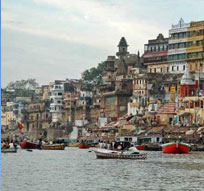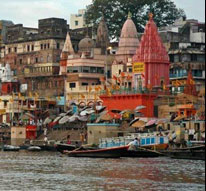Red Fort The largest of old Delhi's monuments is the Lal Quila, or the Red Fort, the thick red sandstone walls of which, bulging with turrets

and bastions, have withstood the vagaries of time, and nature. The Lal Quila rises above a wide dry moat, in the northeast corner of the original city of Shahjahanabad. Its walls extend upto two kilometre, and vary in height from 18 metres on the river side to 33 metres on the city side. Mughal Emperor Shahjahan started the construction of the massive fort in 1638, and work was completed in 1648. It was Sultan Sikander Lodi, who first started to construct a fort here, named the fort Badalgarh. But Akbar, the Mughal Emperor replaced the
fort with this high red sandstone ramparts, which give the fort its
name - the Red Fort. The construction of the Red Fort was completed
by Shahjehan in 1648.
The walls surrounding the fort
extend for more than two kilometers and vary in height between 18
meters and 33 meters. Shahjehan built this fort, as he wanted to
shift his capital from Agra to Delhi. But, before he could do this,
he was captured and imprisoned by his son Aurangzeb in the fort
itself, where he stayed until his last breath. The fort sports all
the obvious trappings, befitting a vital centre of Mughal
government: halls of public and private audience, domed and arched
marble palaces, plush private apartments, a mosque, and elaborately
designed gardens. Even today, the fort remains an impressive
testimony to Mughal grandeur, despite being attacked by the Persian
Emperor Nadir Shah in 1739, and by the British soldiers, during the
war of independence in 1857.
This octagon-shaped
monument has two entrances Lahore Gate and Delhi Gate. Lahore Gate
entrance takes it name from the fact that it faces Lahore, now in
Pakistan. The main entrance of Lal Quila opens on to royal market -
Chatta Chowk that used to house jewelers, weavers and goldsmith.
Chatta Chowk is also known as Meena Bazaar. Red Fort has a hall for
public audience - The Diwan-e-Aam - and a hall for private audience
- Diwan-e-Khas. The Diwan-e-Aam was used by the Mughal emperors to
hold court and to meet dignitaries and foreign emissaries.
It
is believed that enamored by the beauty of Diwan-e-Khas the Mughal
emperor Shah Jahan got the following words engraved on the building:
"If
there is paradise on the face of this earth, it is this, it is this."
The other attractions enclosed within this
monument are the hammams or the Royal Baths, the Shahi Burj, which
used to be Shahjahan's private working area, and the Moti Masjid or
the Pearl Mosque, built by Aurangzeb for his personal use. The Rang
Mahal or the 'Palace of Colors' housed the Emperor's wives and
mistresses. This palace was crowned with gilded turrets, delicately
painted and decorated with an intricate mosaics of mirrors, and a
ceiling overlaid with gold and silver, that was wonderfully
reflected in a central pool in the marble floor. Even today, the Lal
Quila is an eloquent reminder of the glory of the Mughal era, and
its magnificence simply leaves one awestruck. It is still a calm
haven of peace, which helps one to break away, from the frantic pace
of life outside the walls of the Fort, and transports the visitor to
another realm of existence.









